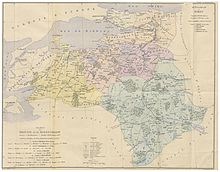|
Mutasarrif Mutasarrif, mutesarrif, mutasarriff, or mutesarriff (Ottoman Turkish: متصرّف, romanized: mutasarrıf, lit. 'plenipotentiary') was the title used in the Ottoman Empire and places like post-Ottoman Iraq for the governor of an administrative district in place of the usual sanjakbey.[1][2] The Ottoman rank of mutasarrif was established as part of a 1864 reform, and its holder was appointed directly by the Sultan.[3] The administrative district under his authority, the mutasarrifate (mutasarriflık),[clarification needed] was officially called a sanjak (سنجاق) in Turkish or liwa (لواء) in Arabic and Persian.[2][4] A mutasarrif was subordinate to a wali or governor-general of a province, while being of superior rank to a kaymakam.[2][5] EtymologyOttoman Turkish mutasarrıf is derived from the Arabic mutaṣarrif, meaning provincial governor.[6] Mutaṣarrif is the active participle of taṣarrafa, meaning "to act without restriction", "have the right of disposing (over somebody or something)".[6] HistoryThis administrative unit was sometimes independent (e.g., Mount Lebanon Mutasarrifate or Cyprus) and sometimes was part of a vilayet (province), administered by a vali, and contained nahiye (communes), each administered by a kaymakam.[7] This rank was established in 1864 against the new Law of Villayets instead of rank of mutesellim which was abolished in 1842.[8] "This small political unit was governed by a non-Lebanese Ottoman Christian subject and given the protection of European powers. The religious communities of the district were represented by a council that dealt directly with the governor. This system provided peace and prosperity until its abolition."[9] The mutassarifates of the Ottoman Empire included:
See alsoReferences
External links |